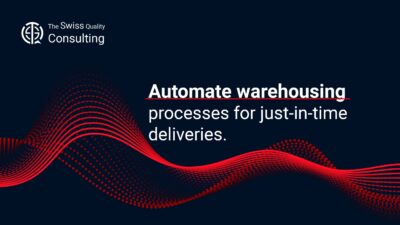Optimizing Warehouse Operations with Automation for Timely Deliveries
Introduction
In the modern logistics landscape, automating warehousing processes for just-in-time deliveries has become a critical strategy for businesses seeking to enhance supply chain efficiency and responsiveness. This article is aimed at business executives, mid-level managers, and entrepreneurs looking to understand the impact of warehouse automation on just-in-time delivery systems.
The Strategic Importance of Warehouse Automation: A Key to Automating Warehousing Processes for Just-In-Time Deliveries
In the dynamic and competitive world of supply chain management, warehouse automation has emerged as a transformative force, leveraging the power of technology to streamline operations, enhance efficiency, and optimize resource utilization. Unlike traditional warehouse management methods that rely on manual labor and paper-based processes, warehouse automation introduces a paradigm shift, embracing robotics, data analytics, and intelligent systems to revolutionize the way goods are stored, moved, and dispatched.
At the heart of warehouse automation lies the pursuit of just-in-time (JIT) delivery, a meticulous approach to inventory management that ensures goods arrive at their destination precisely when needed. By aligning inventory levels with actual demand, businesses can eliminate the burden of excess stock, reduce storage costs, and optimize their cash flow. JIT delivery also minimizes the risk of obsolescence and spoilage, ensuring that products remain fresh, up-to-date, and ready for sale.
To achieve the precision and responsiveness demanded by JIT delivery, warehouse automation employs a range of sophisticated technologies. Automated storage and retrieval systems (AS/RS) utilize robotic cranes and storage systems to efficiently store and retrieve goods, minimizing the time and effort required for picking and packing orders. Automated guided vehicles (AGVs) autonomously navigate warehouse aisles, transporting goods between storage locations and shipping docks, eliminating the need for human intervention and reducing the risk of accidents.
Data analytics and machine learning play a crucial role in optimizing warehouse operations, providing real-time insights into inventory levels, order fulfillment patterns, and potential bottlenecks. By analyzing historical data and current trends, these systems can predict demand fluctuations, optimize stock levels, and identify areas for process improvement. This data-driven approach enables businesses to make informed decisions, streamline operations, and ensure that goods are promptly dispatched to meet customer demand.
The benefits of embracing warehouse automation extend beyond operational efficiency and cost savings; they encompass enhanced customer satisfaction, improved safety, and a competitive edge in the marketplace. By reducing order fulfillment times, minimizing errors, and ensuring timely deliveries, businesses can exceed customer expectations, foster loyalty, and drive repeat business. Warehouse automation also enhances safety by reducing manual handling tasks, minimizing the risk of workplace accidents and injuries.
In essence, warehouse automation is not merely a technological upgrade; it is a strategic imperative for businesses seeking to optimize their supply chains, reduce costs, and achieve just-in-time delivery. By embracing automation, businesses can streamline operations, enhance efficiency, improve customer satisfaction, and gain a competitive edge in today’s dynamic and demanding marketplace.
Reducing Overheads and Enhancing Speed
By leveraging automation, businesses can significantly reduce storage and handling costs while ensuring that products are delivered to customers swiftly and accurately.
Role in Change Management
Integrating warehouse automation is a vital component of change management. As consumer expectations for speedy deliveries increase, businesses must adapt their warehousing practices to stay competitive.
Transitioning to Agile Warehousing Solutions
Adopting automated warehousing systems is key for businesses to remain agile and responsive in the rapidly changing retail and logistics sectors.
Impact on Executive Coaching and Leadership
Effective leadership is integral to successfully implementing warehouse automation. Executive coaching services now emphasize the importance of technological acumen and strategic thinking in managing automated warehousing systems.
Leading with Technological Innovation
Executive coaching prepares leaders to understand and embrace warehouse automation technologies, ensuring they can effectively guide their teams in leveraging these systems for just-in-time deliveries.
Effective Communication in Automated Warehousing
Communicating the benefits and operational changes of automated warehousing effectively is essential for staff buy-in and smooth implementation. Clear communication ensures that all team members are aligned with the new automated processes.
Fostering a Culture of Technological Adaptability
Effective communication about automation strategies can help foster a culture of adaptability and continuous improvement within the organization.
Generative AI in Enhancing Warehouse Automation
Generative Artificial Intelligence (AI) is transforming warehouse automation. AI technologies can optimize inventory management, predict demand, and streamline order processing, further enhancing just-in-time delivery capabilities.
Advancing Warehousing with AI-Driven Solutions
Generative AI offers innovative solutions for warehouse automation, enabling businesses to further optimize their supply chain and delivery processes.
Conclusion
In conclusion, automating warehousing processes for just-in-time deliveries is a game-changer for businesses looking to enhance supply chain efficiency and meet the growing demands for rapid delivery. Through the integration of automation and AI technologies, businesses can achieve greater accuracy, reduce costs, and provide superior customer service.
#WarehouseAutomation, #JustInTimeDelivery, #SupplyChainEfficiency, #AIinLogistics, #OperationalExcellence























